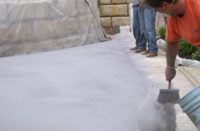Contractors working in decorative concrete can often benefit from the use of water reducers. Here’s a look at two types of decorative concrete work and how water reducers can make the job easier and improve the finished product.
Stamped concrete
Bart Sacco, president of Concrete Texturing Tools & Supply, reports he’s had the best results — as well as the best finishes and durability — when he uses water reducers to achieve a workable slump with minimal bleed water for stamped concrete jobs.
Others agree that for stamped concrete, water reducers improve workability, finishability and strength. But the mix design needs to fit the job.
 As Scott Thome, director of training and product services at L.M. Scofield Co. explains, “Maximum benefit will only be realized when the concrete mix design is optimized for the conditions of a particular job. While the use of standard water-reducing set-controlling admixtures can enhance concrete for stamping, the use of a high-range water reducer would probably not provide adequate water to allow the incorporation of a dry-shake color hardener.”
As Scott Thome, director of training and product services at L.M. Scofield Co. explains, “Maximum benefit will only be realized when the concrete mix design is optimized for the conditions of a particular job. While the use of standard water-reducing set-controlling admixtures can enhance concrete for stamping, the use of a high-range water reducer would probably not provide adequate water to allow the incorporation of a dry-shake color hardener.”
The key to using dry shake color hardeners with mixes containing water reducers, says Tony Schlagbaum, group product line manager at DeGussa Admixtures Inc., is to have enough bleed in the mix to ensure the hardener comes in contact with moisture for a good bond. “Tell the ready-mix producer what you need and the ready-mix producer can come up with the mix design for those specs.”
Sean Fallon, admixture product manager at The Euclid Chemical Co., advises, “The use of a lignosulfonate or sugar-based water reducer will promote bleed and improve bond. It is not a good idea to go below 0.50 water-to-cement ratio for dry shake floors. I have never seen a case in my professional career where using the proper water reducer and adhering to water-cement ratio guidelines, a dry shake hardener failed.”
As far as liquid or powder releases are concerned, there don’t appear to be any problems using them with a mix containing water reducers.
What about integrally-colored concrete? Thome observes that, with proper use, water-reducers will improve integrally colored concrete, much in the same way they improve regular concrete. “The direct benefit is that the color will be stronger with less water; weaker with more water. And the more consistent the concrete appearance is by way of improved placeability and finishing, the more consistent the appearance of the color.
“Also, for a given concrete mix design, increasing the surface area of the materials (fine particles) used will also increase the water demand to maintain a given workability. The use of water-reducer can help offset that unwanted increase in water.”
Experts have mixed comments about using accelerators in conjunction with water reducers for stamped concrete.
 Rick Seymour, technical services manager at Lafarge N.A., says, “With stamping exterior concrete there could be definite advantages, particularly with regards to drying conditions and plastic shrinkage cracking.”
Rick Seymour, technical services manager at Lafarge N.A., says, “With stamping exterior concrete there could be definite advantages, particularly with regards to drying conditions and plastic shrinkage cracking.”
Misuse, however, can create problems, reports Fallon.
Having seen what can go wrong when others have used inappropriate mixes, Sacco prefers that his stamped concrete cure naturally. “When it’s too cold, I just don’t install stamped concrete. It’s not worth the risk.”
Concrete countertops
Many contractors and artists creating pre-cast concrete countertops are experimenting with or using water reducers in their concrete mixes.
Several experts point out that high-range polycarboxylates used in mixes that are self-consolidating produce a smoother, better looking surface with fewer surface blemishes.
Jeffrey Girard, president of The Concrete Countertop Institute, explains, “Instead of simply reducing the mix water while maintaining a moderate slump, polycarboxylates can actually turn a dry, crumbly mix into a pourable fluid, and viscosity modifiers help prevent segregation of the aggregate.”
This results in labor savings, Fallon adds, because it eliminates the need for vibration and for ‘rubbing out’ the bugholes.
Sacco, who has tried polycarboxylate-type water reducers in concrete countertops, says they are good “if you’re going to grind and polish the surface [and] if you want to build strength real quick.”
The amount of water reduction afforded by the use of high-range water reducers is a significant benefit, reports Girard, “because a normal 3,000 psi (compressive strength) concrete has a water-to-cement ratio of about 0.7; eliminating 40 percent of the water lowers that ratio to 0.42, which is usually associated with a 5,500+ psi mix. That’s almost a doubling of the 28-day compressive strength.”
Fallon adds, “Naturally, using any chemical that increases strength and reduces permeability produces the best countertops.”











